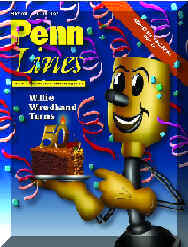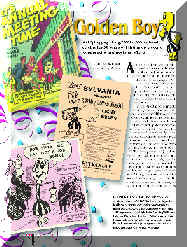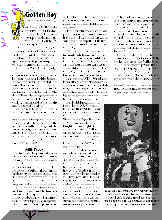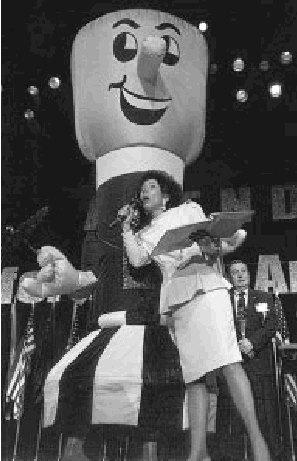|
Willie Wiredhand Turns
50! |
|
Click these Three images to download the PDF files of this Penn Lines Article! |
|
PENN LINES 8 Still "plugging along," Willie Wiredhand celebrates 50 years of lighting up electric cooperative promotional efforts by Richard G. Biever C o n t r i b u t i n g W r i t e r
A touch of tarnish may be creepingacross his brass-plated crown. And the roundness of his waistline is a sure indication that this child of the 1950s is reaching his 50s. But the twinkle in his eye, the smile on his face, the everpresent wave will never age — nor will his dedicated service to electric cooperatives and their consumers.
Willie Wiredhand, complete with a light-socket head, push-button nose and an old-fashioned electrical plug filling out his lower half, celebrates a half century as the official mascot and "spokescharacter" of electric cooperatives this year. The friendly and inspirational figure has come to symbolize dependable, local, consumer-owned electricity all over the world. (In Latin America, for example, he is known as "Electro Pepe.") "Willie" has appeared on just about every type of cooperative promotional item over the years — signage for buildings and substations, T-shirts, ball caps, golf balls, Christmas ornaments, beach towels, night lights and much more. Although his presence on both the local and national stage has declined in recent years in the face of more aggressive cooperative marketing activities,
Willie Wiredhand remains a viable and valuable connection between cooperatives and their consumers. "Willie is one of a long line of industrial spokescharacters that have been used to identify and personalize industrial products and services," notes Margaret Callcott, a research manager for Scripps Networks in Nashville, Tenn., who has written extensively on advertising subjects. "Most companies would love to have a symbol as recognizable as Willie Wiredhand to distinguish them in the marketplace." Origins of an Icon Willie Wiredhand was "born" October 30, 1950, the creation of the late Andrew "Drew" McLay, an entomologistturned- freelance-artist working for the National Rural Electric Cooperative Association (NRECA), based at the time in Washington, D.C. NRECA is the service organization for the nation’s 900- plus electric cooperatives. "We were toying with ideas for an electric cooperative symbol," recalls William Roberts, who in the 1950s served as editor of NRECA’s trade publication Rural Electrification . "I had tossedout the idea that the symbol ought to portray rural electric service as the farmer’s hired hand, which in those days was almost the whole public relations story we wanted to get across. Drew picked up on the idea at my home one night after a couple of beers." Sprawled out on Roberts’ living room floor with a sketchpad, McLay created "Willie the Wired Hand." NRECA’s membership then selected the symbol, shortened to "Willie Wiredhand," as their animated ambassador in 1951. Willie came along in the heyday of "cartoon" advertising, when hundreds of lovable characters — Mr. Clean, Mr. Peanut, Mr. Salty, the Jolly Green Giant and Elsie the Cow — promoted everything from food and household cleaners to stomach antacids. (The first animated "pitchman" dates from 1890s France — the Michelin Man, a guy made of stacked tires.) "These characters exhibited personality — a friendly face and jolly demeanor with which consumers could develop a positive relationship," Callcott remarks, explaining that with the rise of mass production and mass transportation, companies needed a way to make their products stand out and at the same time build consumer loyalty. "For whatever reason, people connect and respond to these characters — they touch a human need to personify things," she adds. "By the time we reach adulthood, personification is ingrained in our psyche: we name our vehicles, plants, even our guns. We are always seeking to relate to them on some human level, never quite believing that somehow they do not have a soul of their own." Callcott emphasizes that utilities in particular needed to personalize a very intangible product. "Willie Wiredhand, Reddy Kilowatt, Katie Kord, Handy Heat and Miss Flame were among the many characters electric and gas companies developed to address this challenge," she says. Reddy vs.Willie Electric cooperatives initially wanted to use Reddy Kilowatt as their spokescharacter. Reddy — depicted with a body, arms and legs of jagged red lightning bolts and a round head equipped with a light bulb nose and outlets for ears — had been around since 1926 and was being used by 188 of the nation’s private power companies as of 1951. However, Reddy’s creator — Ashton B. Collins, who had licensed his character to the private utilities — believed that electric cooperatives were "socialistic" because they borrowed money from the federal government. Not only did Collins refuse to let Reddy be associated with cooperatives, he instructed his lawyers to warn NRECA that any rival character cooperatives might develop would infringe on his exclusive trademarks. Believing that Willie — with his UL-approved (for the era) body — was different enough from Reddy, electric cooperatives pressed ahead with his introduction. "Any similarity between trim, efficient Willie Wiredhand and the shocking figure of Reddy Kilowatt is purely coincidental," NRECA said. After several years of angry exchanges, Collins and a coalition of 109 private power companies formed Reddy Kilowatt, Inc. and on July 14, 1953, filed a federal lawsuit against a South Carolina electric cooperative that was using Willie. Their brief accused electric cooperatives of copyright infringement and unfair competitive practices. For relief, they asked cooperatives to scrap any use of Willie in their advertising efforts and to pay damages. The gist of Reddy’s case was not in how Willie looked, but rather private power company concerns that in marketing electricity "Willie’s poses" would cause public confusion. Willie’s attorneys, however, countered that long before Reddy, other animated characters had seen widespread use in the electric industry as trademarks and promotions. In fact, testimony revealed that Reddy’s handlers had acted like B-grade movie gangsters over the years, using threats of legal action to "unplug" other spokescharacters such as Arkansas Power & Light’s "The Willing Watt," Boston Edison’s "Eddie Edison," Bradford Electric Company’s "Mr. Watts-His-Name" and "Elec-Tric" of Cincinnati Gas and Electric. Finally in June 1956, after a weeklong trial, a federal district court judge in South Carolina awarded the first round of "Reddy vs. Willie" to the cooperatives. Not yet knocked out, Reddy and his crew promptly took their arguments to the Fourth U.S. Circuit Court of Appeals. "This is the most vicious thing that rural electric systems have yet encountered," commented then-NRECA General Manager Clyde Ellis. "We’re not fighting one or 10 power companies, we’re fighting more than 100 of them!" On January 7, 1957, a three-judge panel from the appeals bench issued a unanimous decision in favor of Willie. The court noted similarities between the two characters but added that Reddy "has appeared in thousands of poses doing almost everything possible and in every conceivable activity. The plaintiff has no right to appropriate as its exclusive property all the situations in which figures may used to illustrate the manifold uses of electricity." Out of the victory, Willie came to symbolize more than cooperative friendliness — he was now the true embodiment of cooperative spunk, willing to stand up for consumers in the face of impossible odds against the entrenched might of huge power companies. The phrase, "He’s small, but he’s wirey" became part of the trademark Willie was granted by the U.S. Patent Office in 1957. Willie Revival By the 1970s, the popularity of cartoon spokescharacters began to wane, with most of the few survivors relegated to cereal boxes and snack foods. In Reddy Kilowatt’s case, the energy crunch of the decade made life tough. As demand for electricity outstripped supply, most private power companies simply gave him the pink slip, figuring he was no longer needed as a promotional tool. Willie, on the other hand, rose to meet the energy crisis. He donned a sweater and hopped on a bicycle, caulked windows and weatherstripped doors in new ads pushing energy conservation and efficiency tips. Yet by the early 1980s, many electric cooperatives began to view Willie as antiquated and placed him on a back shelf like an old appliance. Then a surprising development took place — animation made a comeback in the advertising/marketing world, starting with Metropolitan Life Insurance using Peanuts characters to sell financial products. "Much of the rebirth was fueled by the sizable baby boomer market eager to recapture facets of its childhood," Callcott mentions. "King Features Syndicate even took out ‘work wanted’ ads for old cartoon favorites like Betty Boop, Popeye the Sailor and Blondie, hoping to cash in on the nostalgia craze." In response, Willie Wiredhand became the rage in electric cooperative circles once again, though not as a fullfledged marketing vehicle. He had evolved into a pop art celebrity, allowing his image to adorn novelty items like coffee mugs and watches. Even Reddy Kilowatt returned from exile. In 1998, Minneapolis based Northern States Power (NSP), which serves 1.4 million customers in Minnesota, Wisconsin, the Upper Peninsula of Michigan and the Dakotas, bought exclusive rights to the character from Ashton Collins Jr., son of Reddy’s creator. Reddy was outfitted with new sneakers and given a sidekick, Reddy Flame, to promote NSP’s natural gas operations. Reddy quickly experienced somewhat of a brownout, though — in August 2000, NSP merged with Denver, Colo.-based New Century Energies to form Xcel Energy. A spokesman for Xcel Energy says, "Reddy is in a bit of a transition with his new employer. Right now, his duties are largely ceremonial — parades and safety demonstrations." W h i l e W i l l i e a n d h i s spokescharacter friends may rise and fall in prominence over time, Callcott believes consumers can be assured that they will never totally fade away. "The landscape may change, but people do not lose their desire to feel a personal connection to products and services that permeate their lives," she stresses. "If anything, this need intensifies when distribution channels expand — as they did at the turn of the last century when mass industrialization and transportation arrived on the scene and today, with the introduction of the Internet." She concludes, "Unlike human characters, such as Aunt Jemima, Betty Crocker and Uncle Ben, Willie Wiredhand does not require physical updating. As a perky plug, he still represents electricity while allowing cooperatives to leverage their ‘brand’ of reliable, consumer-owned electric power." Richard G. Biever serves as senior editor of Electric Consumer, the statewide electric cooperative publication of Indiana. Golden Boy
A FAMOUS FACE:Willie Wiredhand today lives as a pop art icon. On occasion, he even takes time out of his busy schedule to emcee special events, such as this appearance at the 52nd NRECA Annual Meeting in 1994 to promote the "Friends of Willie" fan club.
STICKING POINT:Patches and stickers featuring Willie Wiredhand were (and still are) commonplace on many uniforms and hard hats, even displayed on toolboxes and vehicles, of electric cooperative line workers and employees around the U.S.
COOPERATIVE SPOKESPLUG: From top, a 1968 comic book featured Willie Wiredhand showing a city family the benefits of cooperative membership; the nation’s electric cooperatives teamed up with Sylvania in 1957 to produce and sell light bulbs featuring Willie; in a February 1957 editorial cartoon, Willie’s creator, Drew McLay, could not resist taking a shot at arch nemesis Reddy Kilowatt and his private power company supporters following years of legal wrangling.
|
|
Willie Wiredhand Turns
50! |
|
Click these Three images to download the PDF files of this Penn Lines Article! |
|
PENN LINES 8 Still "plugging along," Willie Wiredhand celebrates 50 years of lighting up electric cooperative promotional efforts by Richard G. Biever C o n t r i b u t i n g W r i t e r
A touch of tarnish may be creepingacross his brass-plated crown. And the roundness of his waistline is a sure indication that this child of the 1950s is reaching his 50s. But the twinkle in his eye, the smile on his face, the everpresent wave will never age — nor will his dedicated service to electric cooperatives and their consumers.
Willie Wiredhand, complete with a light-socket head, push-button nose and an old-fashioned electrical plug filling out his lower half, celebrates a half century as the official mascot and "spokescharacter" of electric cooperatives this year. The friendly and inspirational figure has come to symbolize dependable, local, consumer-owned electricity all over the world. (In Latin America, for example, he is known as "Electro Pepe.") "Willie" has appeared on just about every type of cooperative promotional item over the years — signage for buildings and substations, T-shirts, ball caps, golf balls, Christmas ornaments, beach towels, night lights and much more. Although his presence on both the local and national stage has declined in recent years in the face of more aggressive cooperative marketing activities,
Willie Wiredhand remains a viable and valuable connection between cooperatives and their consumers. "Willie is one of a long line of industrial spokescharacters that have been used to identify and personalize industrial products and services," notes Margaret Callcott, a research manager for Scripps Networks in Nashville, Tenn., who has written extensively on advertising subjects. "Most companies would love to have a symbol as recognizable as Willie Wiredhand to distinguish them in the marketplace." Origins of an Icon Willie Wiredhand was "born" October 30, 1950, the creation of the late Andrew "Drew" McLay, an entomologistturned- freelance-artist working for the National Rural Electric Cooperative Association (NRECA), based at the time in Washington, D.C. NRECA is the service organization for the nation’s 900- plus electric cooperatives. "We were toying with ideas for an electric cooperative symbol," recalls William Roberts, who in the 1950s served as editor of NRECA’s trade publication Rural Electrification . "I had tossedout the idea that the symbol ought to portray rural electric service as the farmer’s hired hand, which in those days was almost the whole public relations story we wanted to get across. Drew picked up on the idea at my home one night after a couple of beers." Sprawled out on Roberts’ living room floor with a sketchpad, McLay created "Willie the Wired Hand." NRECA’s membership then selected the symbol, shortened to "Willie Wiredhand," as their animated ambassador in 1951. Willie came along in the heyday of "cartoon" advertising, when hundreds of lovable characters — Mr. Clean, Mr. Peanut, Mr. Salty, the Jolly Green Giant and Elsie the Cow — promoted everything from food and household cleaners to stomach antacids. (The first animated "pitchman" dates from 1890s France — the Michelin Man, a guy made of stacked tires.) "These characters exhibited personality — a friendly face and jolly demeanor with which consumers could develop a positive relationship," Callcott remarks, explaining that with the rise of mass production and mass transportation, companies needed a way to make their products stand out and at the same time build consumer loyalty. "For whatever reason, people connect and respond to these characters — they touch a human need to personify things," she adds. "By the time we reach adulthood, personification is ingrained in our psyche: we name our vehicles, plants, even our guns. We are always seeking to relate to them on some human level, never quite believing that somehow they do not have a soul of their own." Callcott emphasizes that utilities in particular needed to personalize a very intangible product. "Willie Wiredhand, Reddy Kilowatt, Katie Kord, Handy Heat and Miss Flame were among the many characters electric and gas companies developed to address this challenge," she says. Reddy vs.Willie Electric cooperatives initially wanted to use Reddy Kilowatt as their spokescharacter. Reddy — depicted with a body, arms and legs of jagged red lightning bolts and a round head equipped with a light bulb nose and outlets for ears — had been around since 1926 and was being used by 188 of the nation’s private power companies as of 1951. However, Reddy’s creator — Ashton B. Collins, who had licensed his character to the private utilities — believed that electric cooperatives were "socialistic" because they borrowed money from the federal government. Not only did Collins refuse to let Reddy be associated with cooperatives, he instructed his lawyers to warn NRECA that any rival character cooperatives might develop would infringe on his exclusive trademarks. Believing that Willie — with his UL-approved (for the era) body — was different enough from Reddy, electric cooperatives pressed ahead with his introduction. "Any similarity between trim, efficient Willie Wiredhand and the shocking figure of Reddy Kilowatt is purely coincidental," NRECA said. After several years of angry exchanges, Collins and a coalition of 109 private power companies formed Reddy Kilowatt, Inc. and on July 14, 1953, filed a federal lawsuit against a South Carolina electric cooperative that was using Willie. Their brief accused electric cooperatives of copyright infringement and unfair competitive practices. For relief, they asked cooperatives to scrap any use of Willie in their advertising efforts and to pay damages. The gist of Reddy’s case was not in how Willie looked, but rather private power company concerns that in marketing electricity "Willie’s poses" would cause public confusion. Willie’s attorneys, however, countered that long before Reddy, other animated characters had seen widespread use in the electric industry as trademarks and promotions. In fact, testimony revealed that Reddy’s handlers had acted like B-grade movie gangsters over the years, using threats of legal action to "unplug" other spokescharacters such as Arkansas Power & Light’s "The Willing Watt," Boston Edison’s "Eddie Edison," Bradford Electric Company’s "Mr. Watts-His-Name" and "Elec-Tric" of Cincinnati Gas and Electric. Finally in June 1956, after a weeklong trial, a federal district court judge in South Carolina awarded the first round of "Reddy vs. Willie" to the cooperatives. Not yet knocked out, Reddy and his crew promptly took their arguments to the Fourth U.S. Circuit Court of Appeals. "This is the most vicious thing that rural electric systems have yet encountered," commented then-NRECA General Manager Clyde Ellis. "We’re not fighting one or 10 power companies, we’re fighting more than 100 of them!" On January 7, 1957, a three-judge panel from the appeals bench issued a unanimous decision in favor of Willie. The court noted similarities between the two characters but added that Reddy "has appeared in thousands of poses doing almost everything possible and in every conceivable activity. The plaintiff has no right to appropriate as its exclusive property all the situations in which figures may used to illustrate the manifold uses of electricity." Out of the victory, Willie came to symbolize more than cooperative friendliness — he was now the true embodiment of cooperative spunk, willing to stand up for consumers in the face of impossible odds against the entrenched might of huge power companies. The phrase, "He’s small, but he’s wirey" became part of the trademark Willie was granted by the U.S. Patent Office in 1957. Willie Revival By the 1970s, the popularity of cartoon spokescharacters began to wane, with most of the few survivors relegated to cereal boxes and snack foods. In Reddy Kilowatt’s case, the energy crunch of the decade made life tough. As demand for electricity outstripped supply, most private power companies simply gave him the pink slip, figuring he was no longer needed as a promotional tool. Willie, on the other hand, rose to meet the energy crisis. He donned a sweater and hopped on a bicycle, caulked windows and weatherstripped doors in new ads pushing energy conservation and efficiency tips. Yet by the early 1980s, many electric cooperatives began to view Willie as antiquated and placed him on a back shelf like an old appliance. Then a surprising development took place — animation made a comeback in the advertising/marketing world, starting with Metropolitan Life Insurance using Peanuts characters to sell financial products. "Much of the rebirth was fueled by the sizable baby boomer market eager to recapture facets of its childhood," Callcott mentions. "King Features Syndicate even took out ‘work wanted’ ads for old cartoon favorites like Betty Boop, Popeye the Sailor and Blondie, hoping to cash in on the nostalgia craze." In response, Willie Wiredhand became the rage in electric cooperative circles once again, though not as a fullfledged marketing vehicle. He had evolved into a pop art celebrity, allowing his image to adorn novelty items like coffee mugs and watches. Even Reddy Kilowatt returned from exile. In 1998, Minneapolis based Northern States Power (NSP), which serves 1.4 million customers in Minnesota, Wisconsin, the Upper Peninsula of Michigan and the Dakotas, bought exclusive rights to the character from Ashton Collins Jr., son of Reddy’s creator. Reddy was outfitted with new sneakers and given a sidekick, Reddy Flame, to promote NSP’s natural gas operations. Reddy quickly experienced somewhat of a brownout, though — in August 2000, NSP merged with Denver, Colo.-based New Century Energies to form Xcel Energy. A spokesman for Xcel Energy says, "Reddy is in a bit of a transition with his new employer. Right now, his duties are largely ceremonial — parades and safety demonstrations." W h i l e W i l l i e a n d h i s spokescharacter friends may rise and fall in prominence over time, Callcott believes consumers can be assured that they will never totally fade away. "The landscape may change, but people do not lose their desire to feel a personal connection to products and services that permeate their lives," she stresses. "If anything, this need intensifies when distribution channels expand — as they did at the turn of the last century when mass industrialization and transportation arrived on the scene and today, with the introduction of the Internet." She concludes, "Unlike human characters, such as Aunt Jemima, Betty Crocker and Uncle Ben, Willie Wiredhand does not require physical updating. As a perky plug, he still represents electricity while allowing cooperatives to leverage their ‘brand’ of reliable, consumer-owned electric power." Richard G. Biever serves as senior editor of Electric Consumer, the statewide electric cooperative publication of Indiana. Golden Boy
A FAMOUS FACE:Willie Wiredhand today lives as a pop art icon. On occasion, he even takes time out of his busy schedule to emcee special events, such as this appearance at the 52nd NRECA Annual Meeting in 1994 to promote the "Friends of Willie" fan club.
STICKING POINT:Patches and stickers featuring Willie Wiredhand were (and still are) commonplace on many uniforms and hard hats, even displayed on toolboxes and vehicles, of electric cooperative line workers and employees around the U.S.
COOPERATIVE SPOKESPLUG: From top, a 1968 comic book featured Willie Wiredhand showing a city family the benefits of cooperative membership; the nation’s electric cooperatives teamed up with Sylvania in 1957 to produce and sell light bulbs featuring Willie; in a February 1957 editorial cartoon, Willie’s creator, Drew McLay, could not resist taking a shot at arch nemesis Reddy Kilowatt and his private power company supporters following years of legal wrangling.
|








